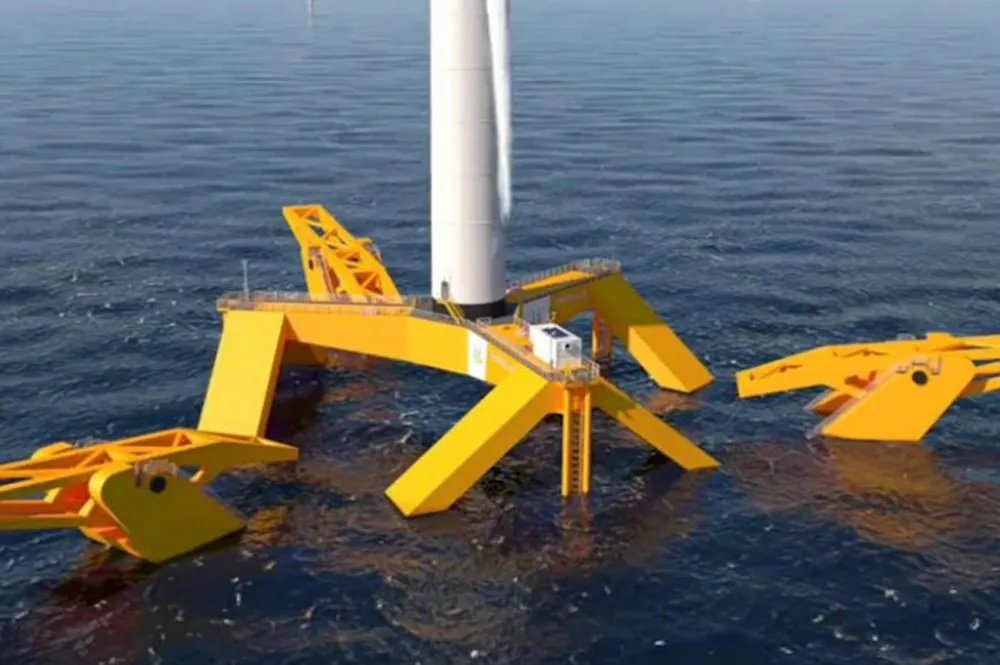Floating wind platform designed 'to cut power cost by 30%' gets $12m funding boost
Gazelle's modular design with dynamic mooring is intended to 'help make floating wind commercially viable'

Floating wind innovator Gazelle Wind Power has secured funding to accelerate development of a 2MW grid-connected demonstrator of a patented platform that aims to take the best features of its more established rivals while, its backers claim, outperforming them.
A funding round led by Portugal's Indico Capital Partners secured €11.4m ($12.1m) for the planned Nau Azul demonstrator project, to be located at Agucadoura, near Viana do Castelo.
In a statement on the funding outcome, Gazelle Wind Power said its floating wind platform was designed to address industry challenges like barriers to high mass production, installation costs, complex supply chain logistics and limited suitable integration sites.
“The Nau Azul project will serve as an example of how to design, build, install, operate and therefore enable cost-competitive floating wind energy generation,” commented Gazelle Wind Power CEO Jon Salazar.
“Indico’s reputation for backing pioneering, sustainable technologies speaks volumes about the potential they see in our floating wind platform technology for unlocking the offshore wind industry globally.”
Announcing the new funding today (Wednesday) Gazelle described a levelised cost of electricity (LCOE) for floating wind that "remains high at around $145/MWh" but stated that it expects to lop up to 30%, off costs with its own design, thus "helping make floating wind commercially viable”.
The platform’s patented dynamic mooring system reduces pitch and balances movement in response to external forces, including wind, waves, and tide.
The lightweight, modular design includes three mooring foundations, each having two lines extending vertically to the hull's outer column arms, resulting in a mooring configuration not dissimilar to a tension leg platform.
However, the load is spreading dynamically through to a counterweight suspended below the centre of the hull creating a structure that is inherently stable — it behaves more like a spar than a semi-submersible structure if the mooring system is disconnected — but with minimal draft once the counterweight is lifted upwards.
The lightweight hull does not use active ballasting systems yet the dynamic response means lower mooring tensions than the TLP, according to Salazar.
'Step change'
The intended advantages of this design include access to ports with just a few metres of draft, unlike the spar.
"We utilise the counterweight to lower the center of gravity, similar to the spar, to provide stability but with one of the lowest drafts you will find globally.... we are aiming for three metres during towing and launch," Salazar stated.
"This is one of the reasons we are saying that we want to use existing port infrastructure and why we are so confident that we represent a step change in bringing down the LCOE and providing what it takes to make a technology insurable and bankable."
As well as the small draft and lightweight structure, the Gazelle platform's pre-laid mooring system is intended to reduce footprint and allowing for rapid connection and disconnection.
"We also eliminate the need for specialised transport vessels during the installation of a location, which is one of the issues of the TLP," Salazar stated.
"Optimising floating technology and bringing down the cost of electricity is not simply a matter of Capex or the weight of the steel. It's also a matter also of Opex and component replacement strategy," said Salazar.
The modularity of the Gazelle platform is also intended to enable a cost-effective approach to fabrication.
Salazar describes an approach close to modern shipbuilding, aiming for optimisation of available space, including use of floating docks, while leveraging the available supply chain and mass producing the technology using flat panel processes.
Stephan de Moraes, co-founder and managing general partner at Indico Capital Partners added: “For costs to be competitive we need new ways to build, install and operate these mega structures. Gazelle offers a solution for that pressing problem of cost competitiveness with a “lego” type of structure that will bring costs down dramatically and enables the installation of deep-sea wind farms all over the world.”
Other backers of the Series A funding included DST, a Portuguese industrial group with plans to supply floating structures in Europe, and investment firms August One and E2IN2.
“Gazelle Wind Power offers an exciting new solution to the complex challenge of creating floating offshore wind farms that are environmentally friendly, cost-effective, and durable in open-sea conditions,” said José Teixeira, Chairman of DST Group.
Permitting for Agucadoura is still ongoing but Salazar says he expects this process to be concluded in the first half of next year.
"We want to kick off manufacturing processes by the end of next year, and I think that we should be operational by 2027," Salazar states.
Iberian demonstrators
Portugal was also a pioneer in hosting the 25MW WindFloat Atlantic floating wind partnership between Ocean Winds, Repsol and technology provider Principle Power which has been operating off Viana do Castelo since 2020.
One year ago, a joint venture between Saitec Offshore Technologies, RWE and Kansai Electric Power started generating electricity from the 2MW DemoSATH floating wind pilot near Bilbao, Spain.
The project aims to enhance the competitiveness and scalability of X1's weathervaning downwind offshore wind turbine configuration which uses a tension leg platform (TLP) hull and single point mooring.
.
(Copyright)